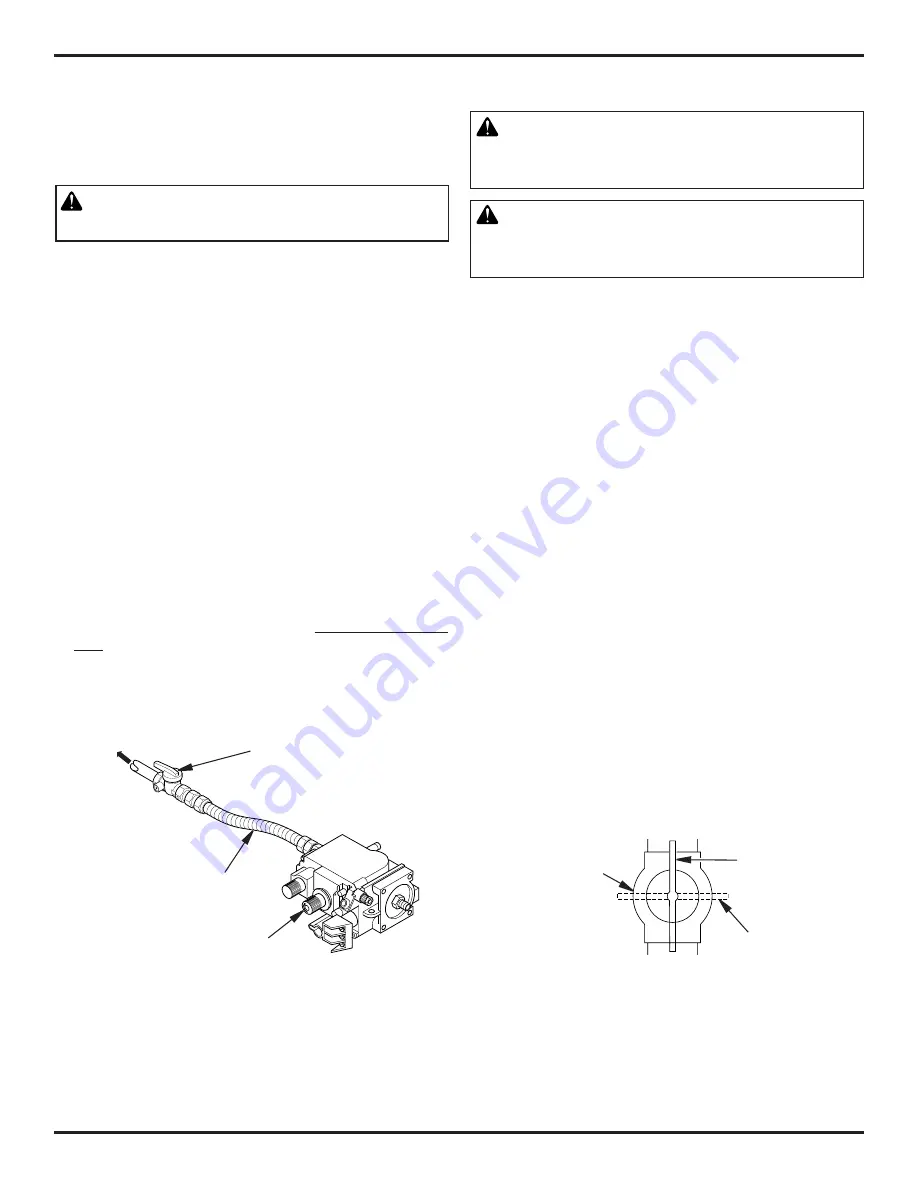
Superiorfireplaces.US.com
126741-01C
14
FIREPLACE INSTALLATION
Continued
Check your building codes for any special requirements for locating
equipment shutoff valve to fireplaces.
Apply pipe joint sealant lightly to male NPT threads. This will prevent
excess sealant from going into pipe. Excess sealant in pipe could
result in clogged fireplace valves.
WARNING: Use pipe joint sealant that is resistant
to liquid petroleum (LP) gas.
We recommend that you install a sediment trap/drip leg in supply line
as shown in Figure 20, page 13. Locate sediment trap/drip leg where
it is within reach for cleaning. Install in piping system between fuel
supply and fireplace. Locate sediment trap/drip leg where trapped
matter is not likely to freeze. A sediment trap traps moisture and
contaminants. This keeps them from going into fireplace gas con-
trols. If sediment trap/drip leg is not installed or is installed wrong,
fireplace may not run properly.
CONNECTING FIREPLACE TO GAS SUPPLY
Installation Items Needed
• 3/4" and a 7/8" open end wrench or adjustable wrench
• sealant (resistant to propane/LP gas, not provided)
1. Remove lower louver door panel by lifting up until disengaged.
Swing forward and out of locating slots at bottom.
2. Route flexible gas line (provided by installer) from equipment
shutoff valve to fireplace. Route flexible gas supply line through
one access hole on each side of fireplace cabinet.
3. Attach flexible gas line from gas supply to the 1/2" flare fitting
provided on control valve (see Figure 21).
4. Check all gas connections for leaks (see Checking Gas Connec-
tions).
CHECKING GAS CONNECTIONS
WARNING: Test all gas piping and connections,
internal and external to unit, for leaks after installing
or servicing. Correct all leaks at once.
WARNING: Never use an open flame to check for a
leak. Apply noncorrosive leak detection fluid to all joints.
Bubbles forming show a leak. Correct all leaks at once.
PRESSURE TESTING GAS SUPPLY PIPING SYSTEM
Test Pressures In Excess Of 1/2 PSIG (3.5 kPa)
1. Disconnect fireplace and its individual equipment shutoff valve
from gas supply piping system. Pressures in excess of 1/2 psig
(3.5 kPa) will damage fireplace gas regulator.
2. Cap off open end of gas pipe where equipment shutoff valve was
connected.
3. Pressurize supply piping system by either opening propane/LP
supply tank valve for propane/LP gas fireplace or opening main
gas valve located on or near gas meter for natural gas fireplace
or using compressed air.
4. Check all joints of gas supply piping system. Apply noncorrosive
leak detection fluid to all joints. Bubbles forming show a leak.
Correct all leaks at once.
5. Reconnect fireplace and equipment shutoff valve to gas supply.
Check reconnected fittings for leaks.
Test Pressures Equal To or Less Than 1/2 PSIG (3.5 kPa)
1. Close equipment shutoff valve (see Figure 22).
2. Pressurize supply piping system by either opening propane/LP
supply tank valve for propane/LP gas fireplace or opening main
gas valve located on or near gas meter for natural gas fireplace
or using compressed air.
3. Check all joints from propane/LP supply tank or gas meter to
equipment shutoff valve (see Figure 23, page 15, for propane/LP
or Figure 24, page 15, for natural gas). Apply noncorrosive leak
detection fluid to all joints. Bubbles forming show a leak. Correct
all leaks at once.
Figure 21 - Connecting Flexible Gas Line to Millivolt Valve
Flexible Gas Line
Do NOT Kink
Equipment
Shutoff Valve
To Gas Supply
(Natural)
To External
Regulator
(Propane/LP)
Control Valve
Figure 22 - Equipment Shutoff Valve
Open
Closed
Equipment
Shutoff Valve















































